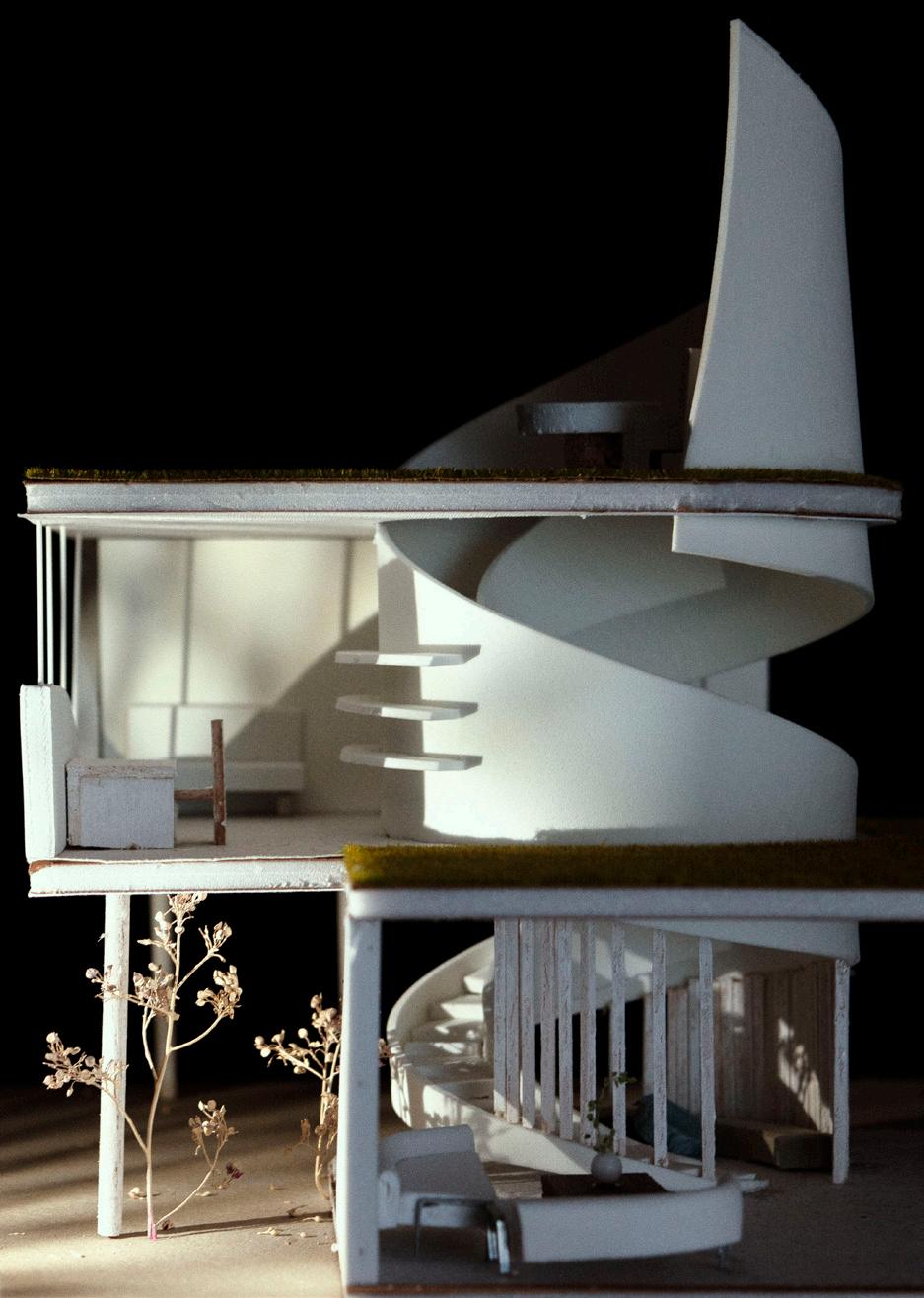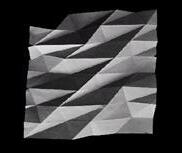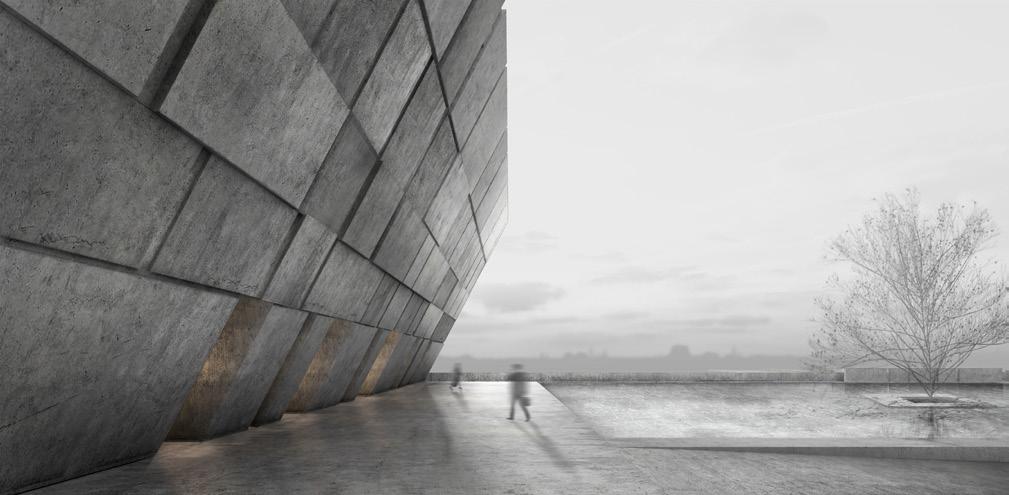SELECTED WORKS
LALEH SADEGHLOO
University of Applied Arts Vienna Institute of Architecture Studio
Greg LynnLale.sadeghloo@gmail.com
004366499520288
For me, in architecture, beyond drawing lines and creating forms, the most crucial issue is awareness. Awareness of the moments which will pass by my construction, or could have passed: cognizance of the concealed and the conspicuous, the ethereal and the tangible, the grotesque and the beautiful. To achieve such awakening, besides buildings, I mingle my fascination with drama, literature, film, music, dance, and all the things helping me to see the big picture, for I believe everything is connected.
EDUCATION |
Present University of Applied Arts Vienna | Studio Greg Lynn Master programme in Architecture
2020 | University of Applied Arts Vienna | Studio díazmoreno garcíagrinda
Master programme in Architecture
2013-2018 | University of Tehran | College of Fine Arts | Tehran, Iran
Bachelor’s of Science in Architecture 3.90 GPA | Highest Honors
2009-2013 | Farzanegan High School Tehran, Iran
High School Diploma in Mathemathics and Physics
National Organization for Development of Exceptional Talents (NODET)
2012-2012 | Chemistry Summer Program | Young Scholar club | Tehran, Iran
EXPERIENCES |
2021-Present | Assistant Architect | StudioVlayStreeruwitz | Vienna, Austria
Design assistance for diverse competitions, illustrations, diagrams and CAD drawings
2017 | Intern Architect | RMJM Arta-Tehran | Tehran, Iran

Design assistance for Iran Historical Car Museum & dafine museum projects
Create physical and digital models, diagrams and technical drawings
2016 | Researcher Center of Excellence in Architecture Technology (CEAT) | Tehran, Iran
Analyze data for The Tenth Seminar series of CEAT : Review of Iran Contemporary Architecture
COMPETITIONS |
2017 | RMJM Design Awards 2017 | collaborative
First Prize In the Best Small/Medium Building for the Iran Historical Car Museum
2017 | Fanavard Design Competition for Pardis Technology Park Entrance, Tehran, Iran | Collaborative Honorable mention
HONORS AND AWARDS |
2015-2017 | Design Excellence Award for Design Studio Project Each Year | University of Tehran, Iran
2017 | Honorable Mention for Fanavard National Competition
Pardis Technology Park Entrance Design, Tehran, Iran
2016 | Best project for “EVOLUTION” (a home for a painter)
The 6th Domus Academy Interior Design Summer School, Tehran, Iran
2016 | UTF Scholarship for First Class Degree
2015 | One of the Best Short Stories in Gardoon Massive Open Online Course (MOOC)
Published on “ketabe dovvom”, Gardoon Publication, Berlin, Germany
2013-2018 | Iran’s National Elites Foundation (INEF) Scholarship
2013 | Ranked 137 out of 340,000 Students on the National University Entrance Exam in Iran
2012 | Silver Medal at 22nd National Chemistry Olympiad, Tehran, Iran
2006 | Selected as an Exeptional Talent by NODET, Iran
INVOLVEMENTS |
2018-2019 | Figurative drawing & illustration courses | Marz Studio Tehran, Iran
2017 | Code-Structed Skins (computational design Workshop)
Contemporary Association of Architects (CAA), Tehran, Iran
2016 | Residential Design, The 6th Domus Academy (Italy) Interior Design Summer School in collaboration with University of Tehran, Tehran, Iran
SKILLS |
Software
Adobe Photoshop (Advance)
Adobe Illustrator (Advance)
Adobe InDesign (Upper-Intermediate)
Rhinoceros (Advance)
Revit (Advance)
Autodesk Maya (Intermediate)
Unity (Upper-Intermediate)
Grasshopper (Intermediate)
Blender (beginner)
AutoCAD (Upper-Intermediate)
MS Office (Advance)
languages Other
English (Fluent)
Spanish (Intermediate)
German (Basic)
Farsi (Native)
Turkish (Native)
Creative Writing in Persian (Advance)
Model making (Advance)
Drawing (Upper-Intermediate)
Painting (Intermediate)
Piano (Upper-Intermediate)
Electric Guitar (Intermediate)
Vocalist (Upper-Intermediate)
Ballet (Intermediate)
One Thousand and One Nights Museum
Final Thesis, Individual Project Instructors: Saeed Haghir Site: Tehran, Abbas Abad Fall 2017

This project is based on my longstanding penchant for telling a story through architecture and writing a play for every single picture seen by the viewer. Everything is not summarized in pictures, indeed. All the senses have to evoke for the story to be told. Between the imagination and reality, there comes the architecture, and behind all the lights and shadows there are manifold ways perceptions.

Which story should it be?
The story in which the ethereal comes into the real and rely on its foundation, same as the architecture. Magical realism is best defined by these words. In Iranian history, magical realism has its very first signs in One Thousand and One Nights stories, even before the emergence of this genre in Latin America. Due to the cultural recession occurring and increasing in Iran day after day, the importance of literature reduces at a mindful pace. The length of these stories and the separation of literary and everyday language in Persian, also makes the society apart from this precious book. The project is aimed to change the existing condition by bringing literature into a more tangible and intriguing form: A Museum. In this museum original illustrations and inscriptions which are kept in national libraries, out of reach for people, are brought out and shown in a modern way, using projectors, instruments, and installations.
I preferred a spatial 3D design method due to the nature of the project. Interior spaces took priority over the exterior forms and faces, and designing bottom-up, frame by frame, made the whole story and building possible. I selected stories in which the critical points of the whole is occurred, and tried to sketch the feelings the story conveyed. By making several physical models based on these sketches, the main structure of the museum came into the life and design process was continued with solving plans and functions.

A city in which all the people had turned into fishes: Water and Light’s Charm (The Story of Fisherman)
Lovers who were burned of God’s anathema, underground (The Story of Second Beggar)
The condition of torment: Transformation of a square to a trapezium (The Story of Hakim)
A broken perspective in time and space
A changing point of view in the story of Sindbad, from Omniscient to the First person
Concatenation (The Story of Shahrazad and Shahriar)
The Story of Design: Spatial Design Process Diagram, including Plan, Section, Sketches and Concept
Site Plan

Access, Topography, and Vegetation Analysis
Road Analysis:
The site is accessible by all highways and thus could play an axial role in changing the vision of Tehran and the contribution of nationals to literature.


















Structural Analysis









 *All photos for this project are from physical models
*All photos for this project are from physical models
Ferris
We adopted a circular ferris wheel concept for circulation through perimeter, combined with an inside atrium for shaping our spaces.

This project is to put aside outside and inside boundaries to make people circulate within the open air and to make the air circulate within the spaces.
started with a given building prototype we provide two ferris wheels as the main circulation method of the building. this safe circulation of people within the open air also speeds up the fresh air around the building. with the addition of other open vertical circulation choices, we created a constant connection between outside and inside spaces all around the facade, while providing a 100% mechanical network to distribute people.
 Studio Greg Lynn Team: Laleh Sadeghloo, Luca Zanarini Winter Semester 2021
Studio Greg Lynn Team: Laleh Sadeghloo, Luca Zanarini Winter Semester 2021
from the inside, a specifically shaped atrium takes the fresh air from the bottom and leads the dirty air to the top while circulating the air within the building. getting help from the bernoulli’s principle. in combination of outer and inner boundaries we created between spaces.













the project gives its users the freedom and independency to move from outside to the target floor. the wheel also provide minimum contact and maximum distance between the visitors. turning in opposite directions on an automatic program, wheels are the safest way to ride without touching, waiting or being interrupted by other people. open lifts are considered for more direct and faster transportation and each of the means stops in different separated space so that there is minimum change of meet for two visitors in a specific place.

https://www.youtube.com/watch?v=-npcnIoyum0
we didn’t design a horizontally distributed conventional building as it leads to have corridors and more infection risk, but we broke this pattern to make people move vertically rather than walking horizontally. obviously in this way relevant spaces are considered to be on top of each other rather than being next to each other. the circulation of people helps air flow in two ways, first with its constant moving around the building that makes the air refreshing quickly, and second with the doors opening and closing constantly that people themselves circulate the air by their distribution.


https://www.youtube.com/watch?v=IduFKutcuee

https://www.youtube.com/watch?v=u1I_swuvLXI&t=31s

Ever-Temporal

 Individual Project Studio Díaz Moreno and García Grinda Site: Pata-Rât, Cluj-Napoca, Romania Summer Semester 2020
Individual Project Studio Díaz Moreno and García Grinda Site: Pata-Rât, Cluj-Napoca, Romania Summer Semester 2020


There is a zero degree alert in Cluj. Toxic substances are leaking from the garbage mountains of Pata Rât, and Someş is in danger of contamination. Activists are talking about an ecological bomb, but also a social one, because 1,500 souls live in the area.
“Nitrate is exceeded 780 times, the fixed residue is exceeded 8.6 times, chlorides are exceeded 12.8 times. The waters are very loaded, they are black. ”





Anothercity
Site: Pata-Rât, Cluj-Napoca, Romania
Summer Semester 2020
An experiential formal approach toward the future temporary living conditions in the same site but this time in an abstract way.

What if every building turns into a living machine which provides energy and exists in the same temporal way.
 Individual Project
Studio Díaz Moreno and García Grinda
Individual Project
Studio Díaz Moreno and García Grinda




One Day

After the Iran revolution in 1979 opera and ballet were banned entirely in the country. This change caused the Persian Ballet Academy to escape to Sweden. My dream is to see Swan Lake on the stage in Tehran, and I designed the project for the hope of freedom. Indeed an imaginary object needs an abstract approach and a futuristic perspective for the structure of the building. The building itself has to speak in a surreal language, though.



A memorial or a wish, all deep yearnings has the same end for recapturing the beauty of moments, and nothing can stir memories better than reflecting it in a more tangible language.
I try to translate the movements of ballet into lines in order to become closer to architecture and design. According to the Italian method, there are eight positions of body which all are occurring on specific points of a square. Getting the lines through this movements brings about several options to be used.


The upper part of Croisé derrière is the main component shaping three different structures by arraying and placing distinctly in three ways.

The outermost structure resembles very much that of a skeleton and keeps all parts of building together by contacting the inner section. Second comes a glass structure to bring the sunlight into the corridors and make the view of park and street possible for out of the main building. Last is the main structure which works as a column with a vertically united shell structure.

There are three floors for three functions: The ballroom at the bottom for rehearsal, the classes in between and the main hall at the top with an extra balcony floor. Restaurant, waiting room and administrative office are also located around the main hall.




 From the Bottom
Aerial and Subtle
Skeleton
Outer Glass Component
Inner Solid Component
Main Hall
First Floor
Section A
Section B
From the Hall’s Interior
From the Bottom
Aerial and Subtle
Skeleton
Outer Glass Component
Inner Solid Component
Main Hall
First Floor
Section A
Section B
From the Hall’s Interior




Gondola
StudiolV, Individual Project Instructors: Alireza Eynifar Site: Tehran, Zargandeh Fall 2016
Designed as five different houses in relation to each other, this project is intended to bring together five poets for living in a small community. The goal is inspiration, strengthening the emotional exchanges and creating a polyphony. The main question is, though: How could five families live closely connected? The project is located on the “Zargandeh” neighborhood (North district of Tehran) known by its old and valuable lands along the stream which comes from “Alborz” mountains, providing an appropriate context for an introvert architecture. As if the building is singing a song, soundlessly.

“Opposites are not to be united rationally. ... In practice, opposites can be united only ... irrationally .” -Carl Gustav Jung










Each house is on two floors to separate private and public parts of the houses. The circular area in a house is formed by a spiral united wall which is extended to the roof. Three parts are on three floors, and a spiral staircase around the wall link them together. On the roof, circular area is allocated for sitting, and the other parts of the roof are designed as roof gardens.







Jung said the words; we find calm by staying on a circle, as when we were in the womb and as we prayed the fire in the middle of a fire temple. Jung describes his tower: “circles of stone, with a heat in the middle.” “I wanted a room in this tower where I could exist for myself alone,” he said, living as simply as possible, without electricity or running water. Our lives surrounded by cubes without any sense of perfection that was painted, written and explained by a “Circle.”



 Wooden Partition System along Curve walls, Providing Optional Private to semi-Private Areas
Left: East Elevation Right: West Elevation
Wooden Partition System along Curve walls, Providing Optional Private to semi-Private Areas
Left: East Elevation Right: West Elevation
CODE-STRUCTED SKINS
COMPUTATIONAL FASHION DESIGN
Academic Series CAAI-Sep2017
Computing ideas for articulated realities

Collaborative Project
Instructors: Arian Hakimi (Zaha Hadid Architects) Stefano Paiocchi (Zaha Hadid Architects)





Team Members: Mahshid Tabatabaie, Sarvenaz Hosseini
We started with an accumulative component which couldn’t be divided into a simple cell. So we tried to change the whole pattern system by playing with grids and vertexes. Moving intersections and vertexes, Bending axes and rotation of grids caused symmetric / Asymmetric, flexible/ rigid, and flatter/ curvier patterns that helped us to discover the behavior of our component to have compatible shapes and curvatures for the human body. These challenges gave us a broader view of folding rules and the ability to analyze the patterns’ act before applying on paper. Our outputs were printed on big rectangles without any dress outline.



















Main Component














Dragon’s Vein
Independent Study, Individual Project Fall 2017, Fall 2018












After finishing the workshop, I tried to transform our pattern to other patterns using transition lines which were created as a result of previous trial and error. These are some seamless patterns transformed between two components, printed on rectangles without any particular outline. Transforms caused dramatic changes in the behavior of our component, in some cases transitions are more apparent, and sometimes it was more seamless as needed. Finally, I made some outlines with no doubt about their afterfolded result, thanks to several experiences done.






Iran National Car Museum
RMJM Arta-Tehran 2017
Head of Design: Arta Rostami
Site: Tehran-Karaj Highway
Contribution: Research, Design Process, Physical and 3D Models, Presentation
The site is located in the industrial zone between Tehran and Karaj (kilometer 10, Fath highway) and it is around 22000 square meters. The existing complex consists of 10 warehouses, each of around 900 (30X30) square meters area, stretching out toward the Tehran-Karaj highway. The constraint is to keep the existing warehouse without exceeding the limit of the existing constructed area.
You can feel a temporal atmosphere which makes the past alive. The historical cars are manifested as living cultural events which may have significance for visitors. By experiencing their own living past, the visitors may set boundaries for future hopes and fantasies. The whole design process for historizing the visitors aims to bring the past alive in the present. I think this will be the way for many projects over the coming years in this country. We are linked inextricably to the past even as we move forward with new technology and design processes. Architecture in Iran has the chance to offer the best of both worlds.



















A renovation project for an old museum: We aimed to add an extra floor on the top of the building in order to create a library, a hall and a circular staircase with which access to all levels would become much more convenient — natural lighting allowed by columns for lightening corridors and main hall during particular situations.




Dafineh Museum
RMJM Arta-Tehran 2017
Head of Design: Arta Rostami Site: Tehran, Mirdamad Contribution: Design Process,Physical and 3D Models, Presentation












I have been exploring the capabilities of AI, using Midjourney and chatGPT to create structures, spatial qualities and expanding specific features into the realm of future. Considering as a study on different aspects such as light, color, scale, fluidity, and movement, this experience with AI opened a window to a new world of possibilities for me.




Here are just a few examples of my Midjourney archive.













A formal experience toward my everlasting interest in geometry. Started with a basic polygon, final forms shaped by multiplying basic and following forms in diverse methods and directions. In between the cuts and overlaps, there exist spaces which are singing different songs, while speaking the same language.







Looking into the anatomy of human body and the shape of bones, structures resemble new spinal columns with their forks. Using colors, lights, and shadows, I tried to play with the symmetry while keeping the whole structures symmetrical.











